Previous issues
- Page Path
- HOME > Browse Articles > Previous issues
- [English]
- Synthesis and Characterization of Tungsten Trioxide Films Prepared by a Sol-Gel Method for Electrochromic Applications
- Tae-Ho Kim, Yoon-Chae Nah
- J Korean Powder Metall Inst. 2015;22(5):309-314. Published online October 1, 2015
- DOI: https://doi.org/10.4150/KPMI.2015.22.5.309
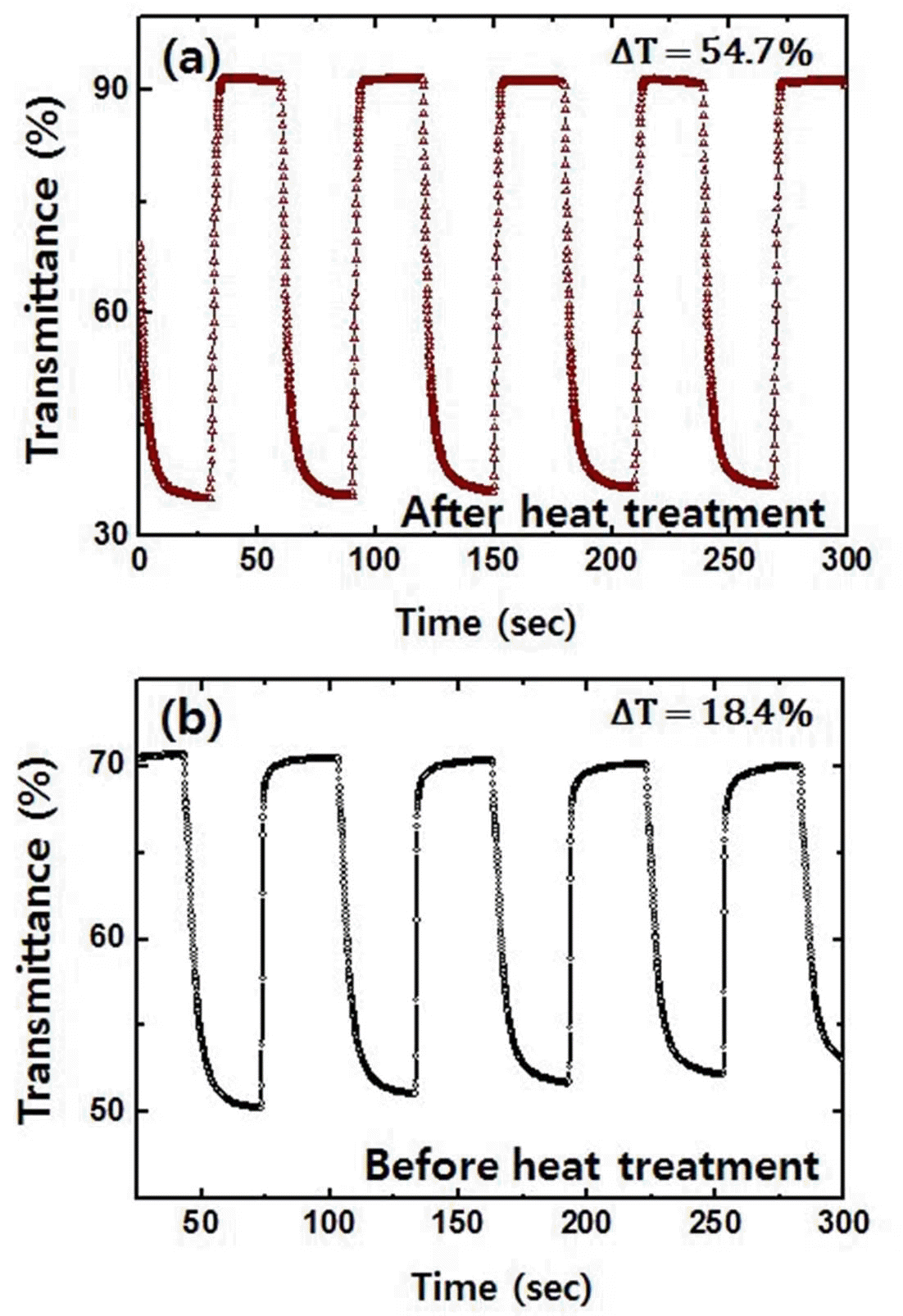
- 532 View
- 5 Download
-
 Abstract
Abstract
 PDF
PDF Tungsten trioxide thin films are successfully synthesized by a sol-gel method using tungsten hexachloride as precursors. The structural, chemical, and optical properties of the prepared films are characterized by scanning electron microscopy, X-ray diffraction, X-ray photoelectron spectroscopy, and UV-Vis spectrophotometry. The electrochemical and electrochromic properties of the films before and after heat treatment are also investigated by cyclic voltammetry, chronoamperometry, and in situ transmittance measurement system. Compared to as-prepared films, heattreated tungsten trioxide thin films exhibit a higher electrochemical reversibility of 0.81 and superior coloration efficiency of 65.7 cm2/C, which implies that heat treatment at an appropriate temperature is a crucial process in a sol-gel method for having a better electrochromic performance.
- [English]
- Using Carboxylmethylated Cellulose as Water-Borne Binder to Enhance the Electrochemical Properties of Li4Ti5O12-Based Anodes
- Lili Liu, Chongling Cheng, Hongjiang Liu, Liyi Shi, Dayang Wang
- J Korean Powder Metall Inst. 2015;22(5):315-320. Published online October 1, 2015
- DOI: https://doi.org/10.4150/KPMI.2015.22.5.315
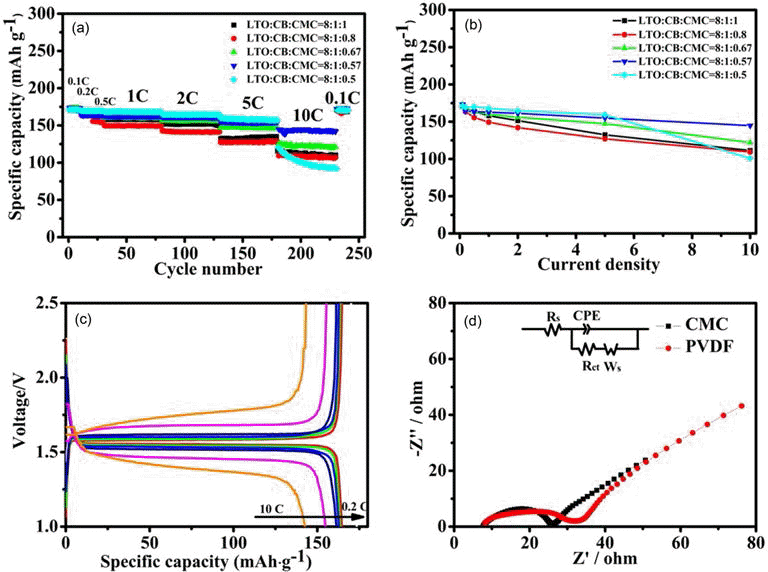
- 773 View
- 8 Download
-
 Abstract
Abstract
 PDF
PDF The present work reports a systematic study of using carboxymethylated cellulose (CMC) as water-borne binder to produce Li4Ti5O12-based anodes for manufacture of high rate performance lithium ion batteries. When the LTO-to-CB-to-CMC mass ratio is carefully optimized to be 8:1:0.57, the special capacity of the resulting electrodes is 144 mAh·g−1 at 10 C and their capacity retention was 97.7% after 1000 cycles at 1 C and 98.5% after 500 cycles at 5 C, respectively. This rate performance is comparable or even better than that of the electrolytes produced using conventional, organic, polyvinylidene fluoride binder.
- [Korean]
- Improvement of Triboelectric Efficiency using SnO2 Friction Layer for Triboelectric Generator
- No Ho Lee, Jae Rok Shin, Ji Een Yoo, Dong Hun You, Bon-Ryul Koo, Sung Woo Lee, Hyo-Jin Ahn, Byung Joon Choi
- J Korean Powder Metall Inst. 2015;22(5):321-325. Published online October 1, 2015
- DOI: https://doi.org/10.4150/KPMI.2015.22.5.321
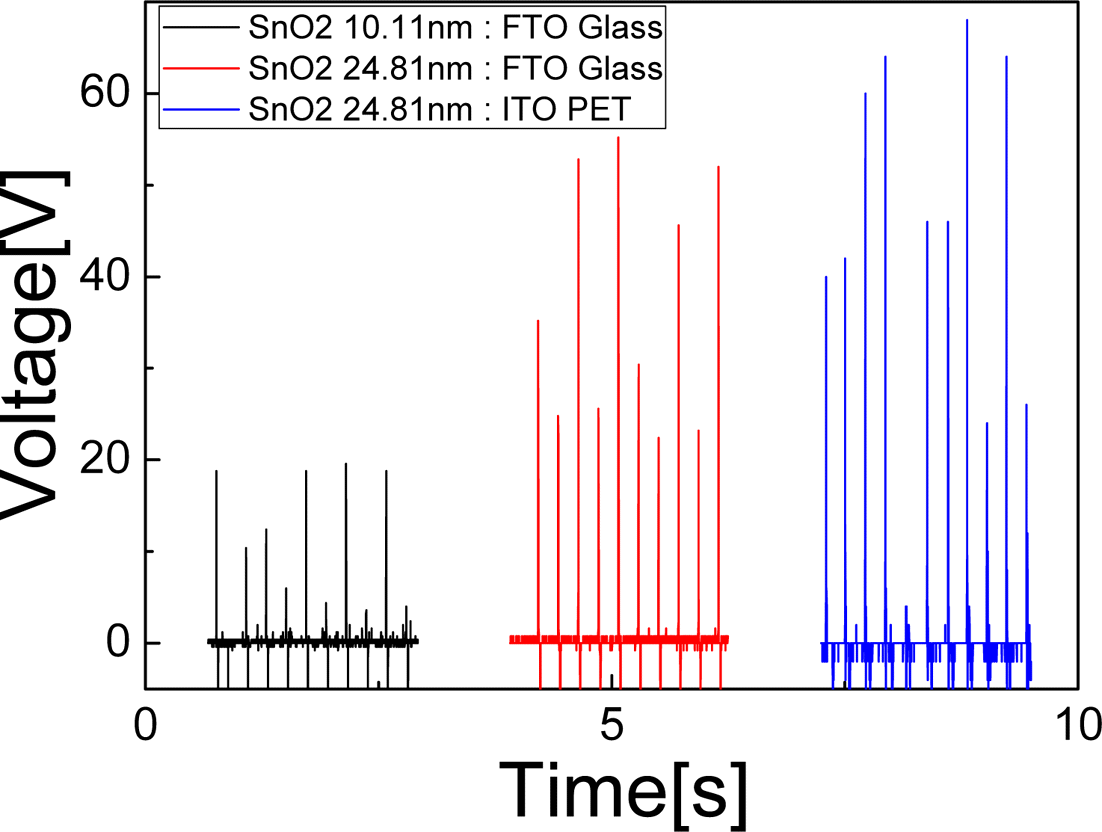
- 806 View
- 7 Download
- 1 Citations
-
 Abstract
Abstract
 PDF
PDF The triboelectric property of a material is important to improve an efficiency of triboelectric generator (TEG) in energy harvesting from an ambient energy. In this study, we have studied the TEG property of a semiconducting SnO2 which has yet to be explored so far. As a counter triboelectric material, PET and glass are used. Vertical contact mode is utilized to evaluate the TEG efficiency. SnO2 thin film is deposited by atomic layer deposition on bare Si wafer for various thicknesses from 5.2 nm to 34.6 nm, where the TEG output is increased from 13.9V to 73.5V. Triboelectric series are determined by comparing the polarity of output voltage of 2 samples among SnO2, PET, and glass. In conclusion, SnO2, as an intrinsic n-type material, has the most strong tendency to be positive side to lose the electron and PET has the most strong tendency to be negative side to get the electron, and glass to be between them. Therefore, the SnO2-PET combination shows the highest TEG efficiency.
-
Citations
Citations to this article as recorded by- Triboelectric charge generation by semiconducting SnO2 film grown by atomic layer deposition
No Ho Lee, Seong Yu Yoon, Dong Ha Kim, Seong Keun Kim, Byung Joon Choi
Electronic Materials Letters.2017; 13(4): 318. CrossRef
- Triboelectric charge generation by semiconducting SnO2 film grown by atomic layer deposition
- [Korean]
- Fabrication of Photoelectrochromic Devices Composed of Anodized TiO2 and WO3 Nanostructures
- Sanghoon Lee, Hyeongcheol Cha, Yoon-Chae Nah
- J Korean Powder Metall Inst. 2015;22(5):326-330. Published online October 1, 2015
- DOI: https://doi.org/10.4150/KPMI.2015.22.5.326
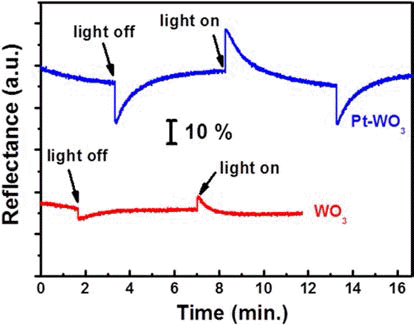
- 513 View
- 3 Download
- 3 Citations
-
 Abstract
Abstract
 PDF
PDF In this study, we demonstrate the photoelectrochromic devices composed of TiO2 and WO3 nanostructures prepared by anodization method. The morphology and the crystal structure of anodized TiO2 nanotubes and WO3 nanoporous layers are investigated by SEM and XRD. To fabricate a transparent photoelectrode on FTO substrate, a TiO2 nanotube membrane, which has been detached from Ti substrate, is transferred to FTO substrate and annealed at 450°C for 1 hr. The photoelectrode of TiO2 nanotube and the counter electrode of WO3 nanoporous layer are assembled and the inner space is filled with a liquid electrolyte containing 0.5 M LiI and 5 mM I2 as a redox mediator. The properties of the photoelectrochromic devices is investigated and Pt-WO3 electrode system shows better electrochromic performance compared toWO3 electrode.
-
Citations
Citations to this article as recorded by- Synthesis and characterization of nitrogen-doped TiO 2 coatings on reduced graphene oxide for enhancing the visible light photocatalytic activity
Yifan Zhang, Hye Mee Yang, Soo-Jin Park
Current Applied Physics.2018; 18(2): 163. CrossRef - Photocatalytic and Adsorption Properties of WO3 Nanorods Prepared by Hydrothermal Synthesis
Su-Yeol Yu, Chunghee Nam
Journal of Korean Powder Metallurgy Institute.2017; 24(6): 483. CrossRef - Synthesis and Photo Catalytic Activity of 10 wt%, 20 wt%Li-TiO2 Composite Powders
Hyeong-Chul Kim, Jae-Kil Han
Journal of Korean Powder Metallurgy Institute.2016; 23(1): 33. CrossRef
- Synthesis and characterization of nitrogen-doped TiO 2 coatings on reduced graphene oxide for enhancing the visible light photocatalytic activity
- [Korean]
- Fabrication of ZnO Nanorod based Robust Nanogenerator Metal Substrate
- Seong-Ho Baek, Il-Kyu Park
- J Korean Powder Metall Inst. 2015;22(5):331-336. Published online October 1, 2015
- DOI: https://doi.org/10.4150/KPMI.2015.22.5.331

- 1,040 View
- 6 Download
- 4 Citations
-
 Abstract
Abstract
 PDF
PDF We report on the succesful fabrication of ZnO nanorod (NR)-based robust piezoelectric nanogenerators (PNGs) by using Cu foil substrate. The ZnO NRs are successfully grown on the Cu foil substrate by using all solution based method, a two step hydrothermal synthesis. The ZnO NRs are grown along c-axis well with an average diameter of 75~80 nm and length of 1~1.5 μm. The ZnO NRs showed abnormal photoluminescence specrta which is attributed from surface plasmon resonance assistant enhancement at specific wavelength. The PNGs on the SUS substrates show typical piezoelectric output performance which showing a frequency dependent voltage enhancement and polarity dependent charging and discharging characteristics. The output voltage range is 0.79~2.28 V with variation of input strain frequency of 1.8~3.9 Hz. The PNG on Cu foil shows reliable output performance even at the operation over 200 times without showing degradation of output voltage. The current output from the PNG is 0.7 μA/cm2 which is a typical output range from the ZnO NR-based PNGs. These performance enhancement is attributed from the high flexibility, high electrical conductivity and excellent heat dissipation properties of the Cu foil as a substrate.
-
Citations
Citations to this article as recorded by- Fabrication of a Graphene/ZnO based p-n junction device and its ultraviolet photoresponse properties
Young-Tae Kwon, Sung-Oong Kang, Ji-Ae Cheon, Yoseb Song, Jong-Jin Lee, Yong-Ho Choa
Applied Surface Science.2017; 415: 2. CrossRef - Fabrication of Porous Polytetrafluoroethylene thin Film from Powder Dispersion-solution for Energy Nanogenerator Applications
Il-Kyu Park
Journal of Korean Powder Metallurgy Institute.2017; 24(2): 102. CrossRef - Morphology Control of ZnO Nanostructures by Surfactants During Hydrothermal Growth
Il-Kyu Park
Journal of Korean Powder Metallurgy Institute.2016; 23(4): 270. CrossRef - Fabrication of ZnO Nanorod/polystyrene Nanosphere Hybrid Nanostructures by Hydrothermal Method for Energy Generation Applications
Seong-Ho Baek, Il-Kyu Park
Journal of Korean Powder Metallurgy Institute.2015; 22(6): 391. CrossRef
- Fabrication of a Graphene/ZnO based p-n junction device and its ultraviolet photoresponse properties
- [English]
- Parameter Investigation for Powder Compaction using Discrete-Finite Element Analysis
- Jinnil Choi
- J Korean Powder Metall Inst. 2015;22(5):337-343. Published online October 1, 2015
- DOI: https://doi.org/10.4150/KPMI.2015.22.5.337
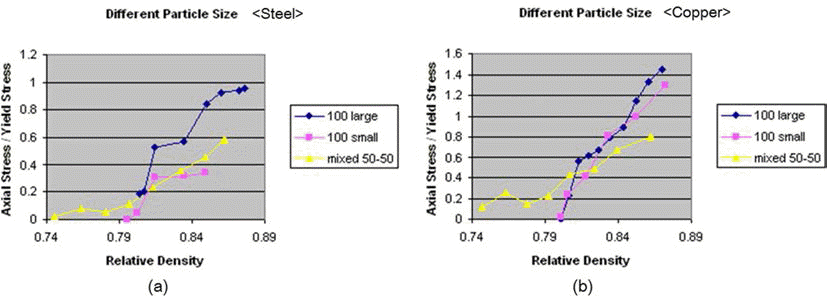
- 769 View
- 6 Download
-
 Abstract
Abstract
 PDF
PDF Powder compaction is a continually and rapidly evolving technology where it is a highly developed method of manufacturing reliable components. To understand existing mechanisms for compaction, parameter investigation is required. Experimental investigations on powder compaction process, followed by numerical modeling of compaction are presented in this paper. The experimental work explores compression characteristics of soft and hard ductile powder materials. In order to account for deformation, fracture and movement of the particles, a discrete-finite element analysis model is defined to reflect the experimental data and to enable investigations on mechanisms present at the particle level. Effects of important simulation factors and process parameters, such as particle count, time step, particle discretization, and particle size on the powder compaction procedure have been explored.
- [Korean]
- Superconducting Properties and Phase Formation of MgB2 Superconductors Prepared by the Solid State Reaction Method using MgB4 and Mg Powder
- Hyeondeok Jeonga, Chan-Joong Kim, Byung-Hyuk Jun, Seolhyang Kim, Hai-Woong Park
- J Korean Powder Metall Inst. 2015;22(5):344-349. Published online October 1, 2015
- DOI: https://doi.org/10.4150/KPMI.2015.22.5.344
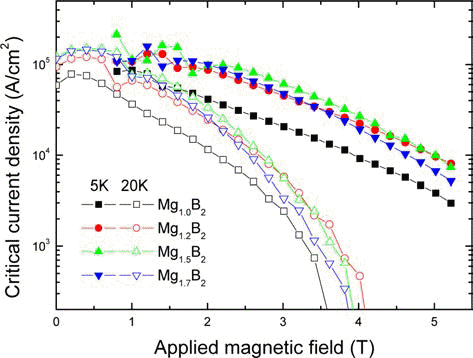
- 532 View
- 4 Download
-
 Abstract
Abstract
 PDF
PDF MgB2 bulk superconductors are synthesized by the solid state reaction of (MgB4+xMg) precursors with excessive Mg compositions (x=1.0, 1.4, 2.0 and 2.4). The MgB4 precursors are synthesized using (Mg+B) powders. The secondary phases (MgB4 and MgO) present in the synthesized MgB4 are removed by HNO3 leaching. It is found that the formation reaction of MgB2 is accelerated when Mg excessive compositions are used. The magnetization curves of Mg1+xB2 samples show that the transition from the normal state to the superconducting state of the Mg excessive samples with x=0.5 and x=0.7 are sharper than that of MgB2. The highest
J c-B curve at 5 K and 20 K is achieved for x=0.5. Further addition of Mg decreases theJ c owing to the formation of more pores in the MgB2 matrix and smaller volume fraction of MgB2.
- [Korean]
- Synthesis of Perforated Polygonal Cobalt Oxides using a Carbon Nanofiber Template
- Dong-Yo Sin, Geon-Hyoung An, Hyo-Jin Ahn
- J Korean Powder Metall Inst. 2015;22(5):350-355. Published online October 1, 2015
- DOI: https://doi.org/10.4150/KPMI.2015.22.5.350
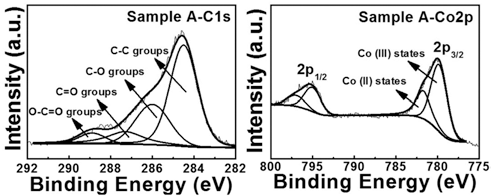
- 659 View
- 3 Download
- 2 Citations
-
 Abstract
Abstract
 PDF
PDF Perforated polygonal cobalt oxide (CO3O4) is synthesized using electrospinning and a hydrothermal method followed by the removal of a carbon nanofiber (CNF) template. To investigate their formation mechanism, thermogravimetric analysis, field-emission scanning electron microscopy, transmission electron microscopy, X-ray diffraction, and Xray photoelectron spectroscopy are examined. To obtain the optimum condition of perforated polygonal CO3O4, we prepare three different weight ratios of the Co precursor and the CNF template: sample A (Co precursor:CNF template- 10:1), sample B (Co precursor:CNF template-3.2:1), and sample C (Co precursor:CNF template-2:1). Among them, sample A exhibits the perforated polygonal CO3O4 with a thin carbon layer (5.7-6.2 nm) owing to the removal of CNF template. However, sample B and sample C synthesized perforated round CO3O4 and destroyed CO3O4 powders, respectively, due to a decreased amount of Co precursor. The increased amount of the CNF template prevents the formation of polygonal CO3O4. For sample A, the optimized weight ratio of the Co precursor and CNF template may be related to the successful formation of perforated polygonal CO3O4. Thus, perforated polygonal CO3O4 can be applied to electrode materials of energy storage devices such as lithium ion batteries, supercapacitors, and fuel cells.
-
Citations
Citations to this article as recorded by- Synthesis of Nitrogen Doped Protein Based Carbon as Pt Catalysts Supports for Oxygen Reduction Reaction
Young-geun Lee, Geon-hyeong An, Hyo-Jin Ahn
Korean Journal of Materials Research.2018; 28(3): 182. CrossRef - Electrochemical Behavior of Well-dispersed Catalysts on Ruthenium Oxide Nanofiber Supports
Geon-Hyoung An, Hyo-Jin Ahn
Journal of Korean Powder Metallurgy Institute.2017; 24(2): 96. CrossRef
- Synthesis of Nitrogen Doped Protein Based Carbon as Pt Catalysts Supports for Oxygen Reduction Reaction
- [Korean]
- Sintering of Fe-30 wt% TiC Composite Powders Fabricated from (Fe, TiH2, C) Powder Mixture
- Byunghoon Lee, Ji Soon Kim
- J Korean Powder Metall Inst. 2015;22(5):356-361. Published online October 1, 2015
- DOI: https://doi.org/10.4150/KPMI.2015.22.5.356
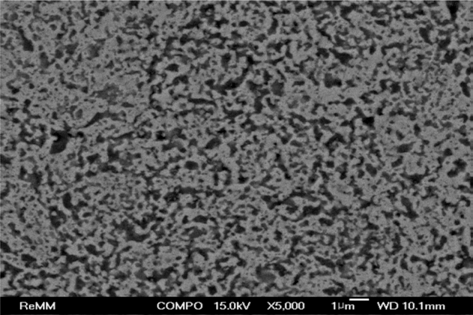
- 674 View
- 1 Download
- 3 Citations
-
 Abstract
Abstract
 PDF
PDF Fe-30 wt% TiC composite powders are fabricated by in situ reaction synthesis after planetary ball milling of (Fe, TiH2, Carbon) powder mixture. Two sintering methods of a pressureless sintering and a spark-plasma sintering are tested to densify the Fe-30 wt% TiC composite powder compacts. Pressureless sintering is performed at 1100, 1200 and 1300°C for 1-3 hours in a tube furnace under flowing argon gas atmosphere. Spark-plasma sintering is carried out under the following condition: sintering temperature of 1050°C, soaking time of 10 min, sintering pressure of 50 MPa, heating rate of 50°C/min, and in a vacuum of 0.1 Pa. The curves of shrinkage and its derivative (shrinkage rate) are obtained from the data stored automatically during sintering process. The densification behaviors are investigated from the observation of fracture surface and cross-section of the sintered compacts. The pressureless-sintered powder compacts are not densified even after sintering at 1300°C for 3 h, which shows a relative denstiy of 66.9%. Spark-plasma sintering at 1050°C for 10 min exhibits nearly full densification of 99.6% relative density under the sintering pressure of 50 MPa.
-
Citations
Citations to this article as recorded by- Abrasive Wear Performance of Spherical Hierarchical Structured TiC/High-Manganese Steel Composites
Tao He, Shengnian Zhao, Dehong Lu, Yehua Jiang, Mojin Zhou
Materials.2024; 18(1): 130. CrossRef - Effect of TiC particle size on high temperature oxidation behavior of TiC reinforced stainless steel
Yeong-Hwan Lee, Sungmin Ko, Hyeonjae Park, Donghyun Lee, Sangmin Shin, Ilguk Jo, Sang-Bok Lee, Sang-Kwan Lee, Yangdo Kim, Seungchan Cho
Applied Surface Science.2019; 480: 951. CrossRef - Effect of TiC addition on surface oxidation behavior of SKD11 tool steel composites
Seungchan Cho, Ilguk Jo, Heebong Kim, Hyuk-Tae Kwon, Sang-Kwan Lee, Sang-Bok Lee
Applied Surface Science.2017; 415: 155. CrossRef
- Abrasive Wear Performance of Spherical Hierarchical Structured TiC/High-Manganese Steel Composites
- [Korean]
- Effect of Sublimable Vehicle Compositions in the Camphor-Naphthalene System on the Pore Structure of Porous Cu-Ni
- Na-Yeon Kwon, Myung-Jin Suka, Sung-Tag Oh
- J Korean Powder Metall Inst. 2015;22(5):362-366. Published online October 1, 2015
- DOI: https://doi.org/10.4150/KPMI.2015.22.5.362
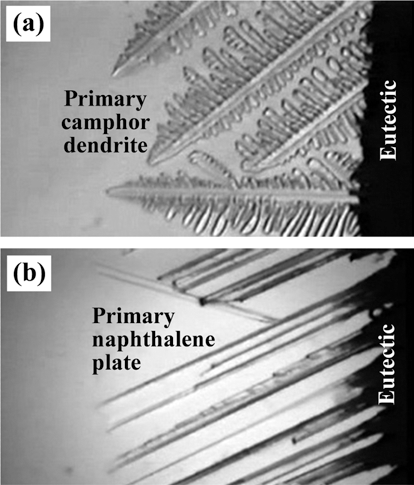
- 800 View
- 1 Download
- 2 Citations
-
 Abstract
Abstract
 PDF
PDF The effect of sublimable vehicle composition in the camphor-naphthalene system on the pore structure of porous Cu-Ni alloy is investigated. The CuO-NiO mixed slurries with hypoeutectic, eutectic and hypereutectic compositions are frozen into a mold at -25°C. Pores are generated by sublimation of the vehicles at room temperature. After hydrogen reduction at 300°C and sintering at 850°C for 1 h, the green body of CuO-NiO is completely converted to porous Cu-Ni alloy with various pore structures. The sintered samples show large pores which are aligned parallel to the sublimable vehicle growth direction. The pore size and porosity decrease with increase in powder content due to the degree of powder rearrangement in slurry. In the hypoeutectic composition slurry, small pores with dendritic morphology are observed in the sintered Cu-Ni, whereas the specimen of hypereutectic composition shows pore structure of plate shape. The change of pore structure is explained by growth behavior of primary camphor and naphthalene crystals during solidification of camphor-naphthalene alloys.
-
Citations
Citations to this article as recorded by- Freeze Drying Process and Pore Structure Characteristics of Porous Cu with Various Sublimable Vehicles
Gyuhwi Lee, Sung-Tag Oh, Myung-Jin Suk, Young-Keun Jeong
Journal of Korean Powder Metallurgy Institute.2020; 27(3): 198. CrossRef - Interaction of Solid Particles with the Solidifying Front in the Liquid-Particle Mixture
Ho-Suk Lee, Kyu-Hee Lee, Sung-Tag Oh, Young Do Kim, Myung-Jin Suk
Journal of Korean Powder Metallurgy Institute.2018; 25(4): 336. CrossRef
- Freeze Drying Process and Pore Structure Characteristics of Porous Cu with Various Sublimable Vehicles
TOP
 KPMI
KPMI




 First
First Prev
Prev


